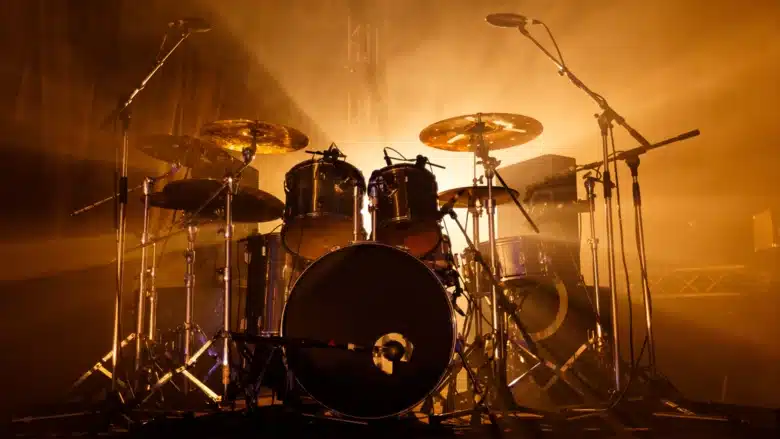Simply for the rhythms and the beats. Whether in the 20s Jazz age to the ever-rocking Rock n Roll era of the 40s. Giving us the legendary artist Ringo in the 60s and being widely use in the metal genre. Drums have been an integral part of the world of music. In this blog, we will be talking about drums, modern drumkits, and their various parts.
Drums
Drums have been around us for quite a long time. The earliest known drums were found in China dating back to 5500 BC and were made from alligator skin. The drum is a membranophone. In other words, drums fall into the category of instruments that produce sound through a stretched membrane. Through the years the drums evolved from frame drums to classical drums which later made the way for a drumkit and finally gave us the modern drum kit.
Drum kit
The modern drumkit that we get to see and hear today started to take shape during the 20s jazz in New Orleans. The jazz drummers started to put together different drums and percussions with different tonal qualities. The modern drumkit layout includes a snare drum, bass drum, hi-hats, tom-toms, ride cymbals, and crash cymbals.
Parts of the Drumkit
Snare Drum
The snare drum is a two-sided or two-headed drum. The early versions of the snare drum used to produce a heavier sound. In the 19th century, the snare drum underwent drastic changes. The modern snare drum consists of a cylindrical shell made from plywood or metal. The dimensions of the snare drum are as follows; The depth of the snare drum can range from 5 inches to 8 inches and the diameter can be from 12 inches and 14 inches. When we play the snare drum it results in producing snappy and a relatively high-pitched sound. The following audio is the sound of the snare drum.
Bass Drum
The Bass drum is the largest part of the drumkit. Originating in Turkey, the earliest version of the bass drum is the davul which existed in the 1300s. In the earlier days, davul was played with a stick. But in today’s time, we use a bass pedal or a single pedal-operated stick for playing the bass drum. Consisting of a cylindrical shell,
The material used in creating the shells are wood and sometimes metal. Most of their sizes range from 22 inches in diameter to 16 inches in depth. The sound produced when we play the bass drum is the deepest and the heaviest among the family of drums. The following audio is the sound of the bass drum.
Hi-Hats
The Hi-Hats are relatively a recent edition of the drumkit. The emergence and prevalence of Hi-hats in mainstream music can be seen during the 1930s. The “Low boy” or the first spring-operated cymbal paved the way for the Hi-hats. Hi-hats are a combination of 2 cymbals. Consisting of 2 metals cymbals. Both the cymbals are put together on a stand facing each other like a sandwich. We can play it with a foot pedal or by striking it with drumsticks.
The sound produced when playing the Hi-hats is high-pitched in comparison to other cymbals. We mainly use the Hi-hats for maintaining time and tempo markings. The following audios are the sound of hi-hats when played in different manner.
Toms
You will see that a five-piece drumkit will always consist of the Toms also known as Tom-toms. Originating in China from the gong-like instrument known as Tam-tam. The first arrival of Tom-toms in the United States took place in the 1800s by Chinese and other immigrants. The Tom-toms produce a sound with a deeper tonal quality than a Snare but not as low as a Bass drum. There are different types of Tom-toms such as
Floor toms: The floor toms are among the instruments which produce the lowest-pitched sounds in a classic five-piece drum kit. The following audio is the sound of the floor toms.
High toms and Mid toms: High toms and mid toms have many names such as Rack toms, hanging toms, or mounted toms they are smaller than floor toms. The following audio is the sound of the medium toms.
Roto toms: The Roto toms are a lesser-known type of Tom-toms. These tom toms do not have a drum shell and are usually not seen as part of the classic five-piece drumkit. The following audio is the sound of the roto toms.
Concert toms: The Concert toms are more melodic in nature and are closely related to the floor toms and the rack toms.
The dimensions of the Tom-toms also vary according to the musicians and genre of the music. For instance, the size of the shell of the Tom-toms ranges from 10 inches to 12 inches, or 14 inches in a jazz drum set. Whereas the shell size of Tom-toms ranges from 12 inches to 13 inches, and 16 inches by rock musicians.
Ride Cymbal
The Ride cymbal is the most common and usually the largest of the cymbals that are present in the drumkit. Initially known as Charleston cymbal. They were first used in military bands. The material used in creating the ride cymbals are zinc alloy and copper. Ride cymbals play an extremely important role in keeping the rhythm, tempo, and beat constant. The bell-shaped construction in the middle of the ride cymbal results in the production of a high-pitched sound when struck. The following audio is the sound of the ride cymbal.
Crash Cymbal
The Crash cymbal is a thin cymbal. It is not used as frequently as the ride cymbal. Often the Crash cymbal is used to bring up energy and excitement. It usually measures around 20 inches to 22 inches in diameter. The Crash cymbal is struck harder than a ride cymbal. It also excites faster than a ride cymbal when struck on the edge. The material used in creating the crash cymbals is tin alloy and copper. Thus, when playing the Crash cymbal results in producing a cutting, thin and bright sound. The dimensions are usually 16 inches which lie somewhere in between the Hi-hats and ride cymbal. The following audio is the sound of the Crash cymbal.
Other Percussions
There are other percussions that can also be included in a modern drumkit such as a crash/ride cymbal, splash cymbal, China cymbal, etc.
China Cymbals
The China cymbals as the name suggest originated in China. When struck the China cymbal produces a crashy, metallic, exotic, and harsher sound. The material used in the making of China cymbals is a combination of tin and copper alloy. The dimension of the smallest China cymbal can be 8 inches and the larger China cymbals can go up to 24 inches. Many China cymbals have rims in a reverse direction and are also often put in an inverted manner on a cymbal stand. The following audio is the sound of the China cymbal.
Splash Cymbal
Often used for uplifting the mood or for adding more accents. Splash cymbals are thin cymbals size ranging around 8 inches in diameter. They excite fast and have a quick decay as well then can be also seen as a tiny crash. The following audio is the sound of the Splash cymbal.
Conclusion
Many monumental changes and inventions by countless talented individuals gave us new drums and cymbals which offered differently pitched sound, tonal quality, resonance, etc. For instance, Avedis Zildjian III a Turkish immigrant whose company went on creating the cymbals that we use today. During the 30s and the 40s, the world was introduced to the likes of great drummers like Gene Krupa, Chick Webb, and “Papa” Jo Jones. Drums have also been an indispensable part of the music world and are one of the reasons because of why we are able to experience different rhythms and beats. Lastly, follow the rhythm and keep drumming.































